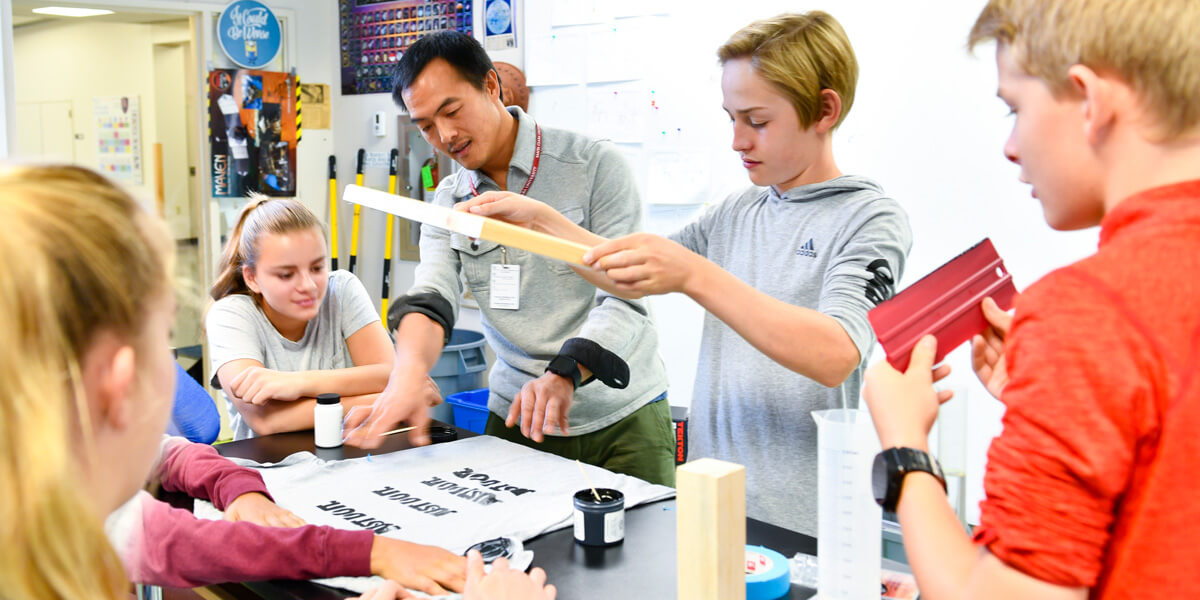When Hidai Olivas-Holguin ’17 arrived as a Freshman at Massachusetts Institute of Technology (MIT), she was pleasantly surprised. “Even at MIT where everyone is so accomplished, I had received more of a Computer Science education at CA than many of the other students had received at their schools,” she says. “Kids were shocked to find out that I had been able to take three computer science courses in high school—including AP Computer Science and Advanced Algorithms and Data Structures.”
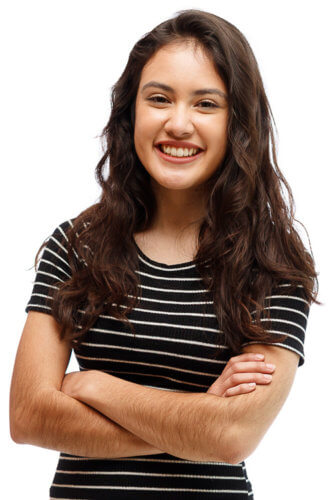
Olivas-Holguin also credits the course she took in Colorado Academy’s Anderson Innovation Lab for preparing her for the work at MIT. “Programming is an amazing skill, but you need to have the hands-on experience,” she says. “You have to think about the whole process of making a product, instead of just thinking about a program that works.”
During the summer after she graduated from CA, Olivas-Holguin interned at Ibotta, the mobile technology company founded by CA parent Bryan Leach. Last summer, Olivas-Holguin interned in the New York office of Google, where she built an android app that used a machine learning model. Her goal continues to be to have her own company—a goal that started with her education in Computer Science, Engineering, and Design at CA.
“The beauty of teaching STEAM (Science, Technology, Engineering, Art/Design, and Math) is that these courses are interdisciplinary by nature—they overlap and don’t fit neatly into silos, and we recognized that,” says Jon Vogels, PhD, Upper School Principal. “This is an area where we have to be adaptable, nimble, and open to change, and luckily we have a faculty who appreciate that and are willing to develop courses that help students think expansively and learn in a developmentally appropriate way—starting in Pre-Kindergarten!”
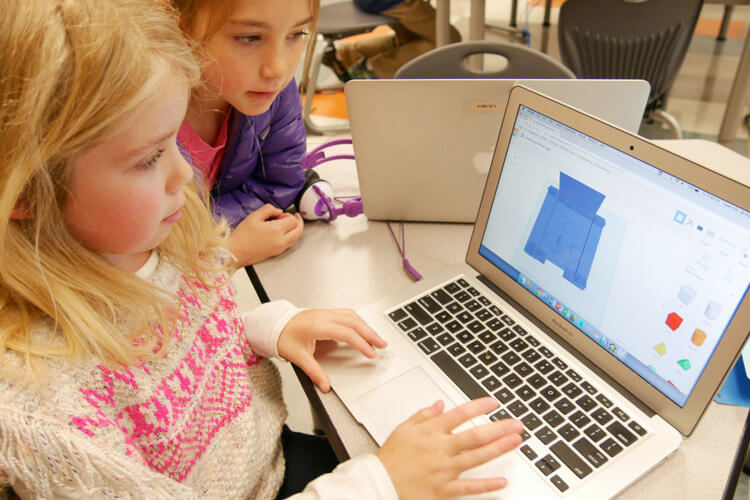
Lower School: The building blocks
What does Lower School Technology Coordinator Bill Witt hear most often in the iLab when very young students begin to discover coding?
“Something happened!” which usually means, “Something went wrong.”
Witt’s response sets the stage for learning in all future grades at CA. “I say to them, ‘Tell me what’s wrong, and tell me how you are trying to fix it,’” he says. “This is the foundation for problem solving.”
Pre-Kindergarten and Kindergarten students start their engineering experience at CA with Legos®. They quickly move on to solving coding challenges moving Bee-Bots®, programmable robots, around Lego® obstacles they build. “We are introducing beginning coding, sequencing, and problem solving and collaboration, because they have to work in pairs,” Witt says.
The work in the iLab is reinforced in the Pre-K classroom, where Director Mary Karst conducts a “Mini Innovation Lab,” allowing students to create from their imagination. “With their inquisitive minds, Pre-K students are at the perfect age to explore and find new ways to create and build,” says Karst. “During lab time, we spend time thinking and planning, because we believe the process is just as important as the product.”
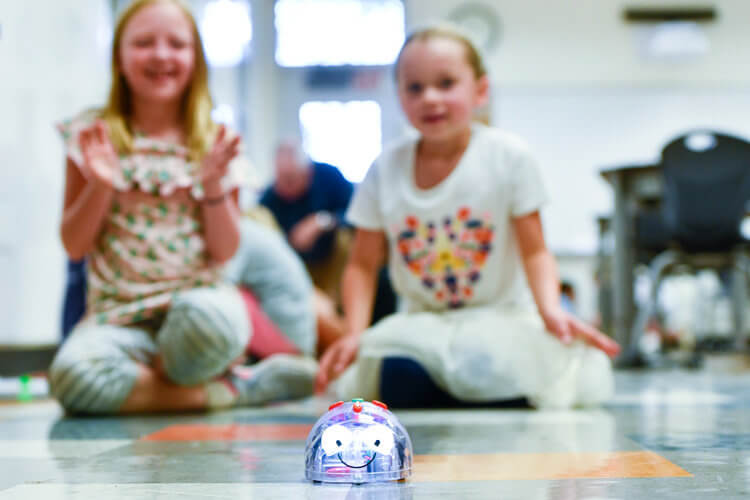
By Grades 3-5, Lower School students graduate to Ozobots which can be programmed using a combination of color paths. Grades 4-5 also use Dash and Dot to accomplish a series of programming challenges. Volunteers participate in the international Wonder League Robotics Competition, giving up lunch recess to tackle coding challenges. “It involves your imagination,” says Kyle Manzo, as he launches Dash on another venture. “You have to be creative with the code.”
In Stashia Taylor’s Grade 4 and 5 art classes, students engage in learning experiences that dovetail with their iLab work. They use circuits, small motors, and other basic tech components in art pieces that ultimately are placed in a larger interactive art installation. The iLab work is also reinforced in Lower School science classes with the use of Lego® WeDo robots.
Some students add to their coding skills by enrolling in an after-school program offered by MindDance. They use Scratch, an MIT-developed computer programming language for children to create video games, animated stories, and interactive art. Students also have the opportunity to work with Makey Makeys®, an invention kit that turns everyday objects into touchpads that activate circuits. All students have experience with 3D printing by the time they leave Lower School. The 1:1 program—one iPad per student—begins in the Fifth Grade and continues through Upper School.
“By the time they are in Grade 5, they have confidence in their ability to choose the right approach to a programming, engineering, or design challenge,” Witt says. “It’s thrilling for them, and they don’t want to stop.”
Middle School: A time for risks and rewards
Jennie Kies, Technology Integration and Innovation Specialist, believes Middle School students are the perfect age for further exploration with engineering and design. “They are open and excited,” she says. “They are willing to take risks, try new things, and learn from their missteps.”
In Grades 6 and 7, Kies teaches the steps of the design process, with an emphasis on the iterative nature of any design. “It’s not like tying your shoes where if you do the steps your shoes will be tied,” she says. “Here you might have to go back to redesign or skip ahead to test a prototype. It’s a non-linear process.”
Students in Grade 6 focus on a fundamental understanding of circuits, building a toy with lights. Building on that experience, students in Grade 7 use light and sound sensors to design a robot pet for their clients—Kindergarten students—and Kindergartners then test and critique the finished product.
“If you paid me money, I couldn’t predict what my students are going to come up with for the Robot Petting Zoo!” says Middle School Tech Coordinator Allie Bronston. “Who could have predicted a koala unicorn?”
Bronston points out that Middle School reviews and builds on what students have already learned in Lower School—computational thinking, which emphasizes step-by- step logical planning to reach a successful end result. “Much of education is about right and wrong answers, but our course is about infinite possibilities and the 21st century skills that will serve students in Upper School and their future education,” Bronston says.
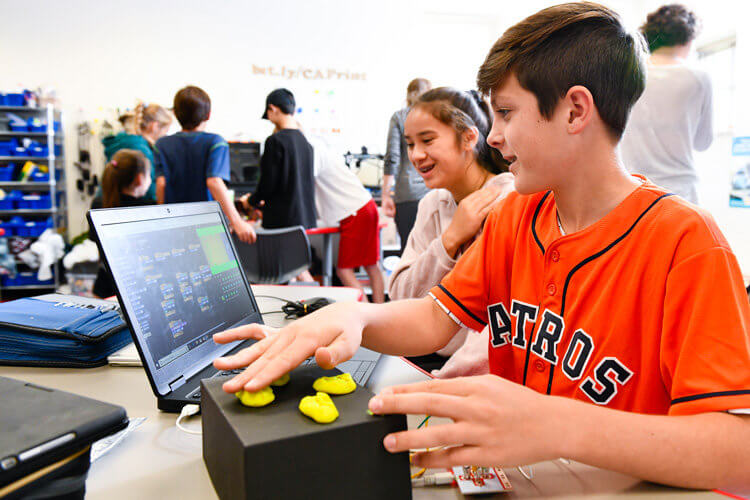
Middle School Design and Innovation Studio
The Middle School Design and Innovation Studio includes 3D printers, a laser cutter, a Computer Numeric Control (CNC) tool for cutting, carving, machining and milling, hand tools, glue guns, littleBits, and recycled materials for students to use in any project. At first, students just used the tools to build class projects. Now, Kies is tracking a new trend—a dramatic increase in students coming in to use the tools to create personal projects they have designed.
For inspiration, students need look no further than Kies, who proudly displays the six prototypes she designed and built before creating her final product—a glue gun station safely storing multiple hot glue guns. Kies, who has a degree in manufacturing and a background in engineering, shares her passion with her students. “I’m a giant nerd and proud of it,” she says. “I think it’s especially important that Middle School girls can see how much fun design and building is, because that will increase their participation in these fields later in life.”
By Grade 8, students in Middle School have the opportunity to explore the physical world in a course that blends traditional physics and chemistry with technology and robotics. Students review basic programming and use Sphero (made famous by “Star Wars”) to practice their skills. They design and launch bottle rockets to study aerodynamics and rocketry.
In their interdisciplinary elective STEAM, students collaborate as artists and engineers using spatial visualization to design solutions to basic and complex problems. “We use origami, which many people think of as art,” says MS Science teacher Thanh Luong, “but we take it a step further to see how it’s the same fundamental skill used to efficiently design bridges and buildings.”
Students in the Middle School also can participate in multiple Robotics Teams using Lego® Mindstorms EV3 robots. CA’s strong emphasis on “design thinking” at the Middle School level means that every student in every class will do one project that involves design thinking—identifying problems, gathering and analyzing information and evidence, getting feedback, making revisions, and making decisions.
“I love teaching students at this level,” Luong says. “It’s learning through experimenting, and instead of just accepting technology, students learn how technology and society are progressing together.”
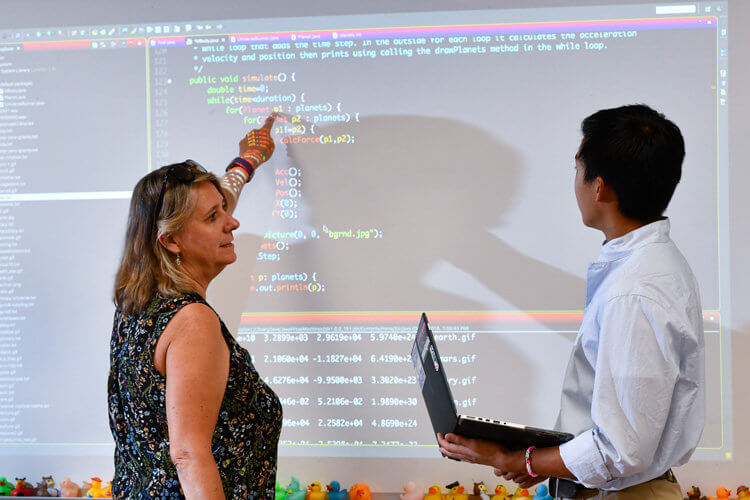
Upper School: Making people’s lives better
By the time CA students reach Upper School, they no longer say “Something happened!”
Dr. Jon Vogels points out that “More likely, you will hear this: ‘I’m going to make something happen that’s never happened before!’”
CA requires that all Upper School students take 2 trimesters of Computer Science/Engineering & Design offerings to graduate. “I needed to fulfill the requirement,” says Senior Alena Holbert, “and I accidentally found out I was really interested in computer science.” After Holbert took Introduction to Programming with Python her Freshman year—she never looked back. Four years later, she has flown through CA’s Computer Science curriculum. She is now doing an Independent Study “From Nand to Tetris: Building a Modern Computer” with Kimberly Jans, Upper School Computer Science and Technology Coordinator.
After 18 years teaching at CA, Jans can remember the early, lean years when she might only have one student in AP Computer Science. This year, her AP class is at maximum enrollment. “They work hard, and often they fail—and then boom, it works and their faces just glow,” Jans says. “They are learning computational thinking and those skills are easily applied to other courses and their future careers—whether they become scientists, doctors, teachers, lawyers, or CEOs. You never quite understand our world if you don’t have basic coding and computer science.”
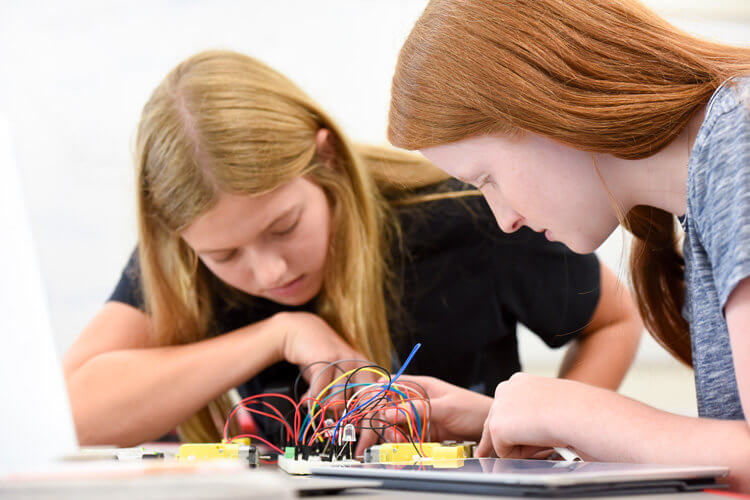
CA students had to look twice on a recent morning when they noticed a robotic boat sailing across the CA pool. “They just took their ideas and ran with it,” laughs Sean Gallop, Upper School Robotics and Computer Science teacher. Students who have a passion for robotics find plenty of opportunities at CA to design, build, test, and refine robotic systems with an emphasis on working on teams to address a community need. Gallop has written an electronic textbook for robotics and Python, and now he has flipped his classroom, offering lecture material in the interactive book, freeing up his time to work individually with students to help develop their skills.
Teachers in the Upper School Visual Art Department put the “A” in STEAM with courses in Architectural Drawing where students learn basic drafting and drawing skills on paper before transitioning to the 3D modeling software SketchUp. In Digital Fabrication Art, students use the software CorelDRAW® to create 2D and 3D art on a laser cutter. “Artists have a tenacious approach to problem solving,” says Katy Hills, who teaches Visual Art. “They make many “mistakes” that evolve into solutions. They learn to use tools by making something completely unique, and their motivation to learn technology is powered by their passion to make something personal.”
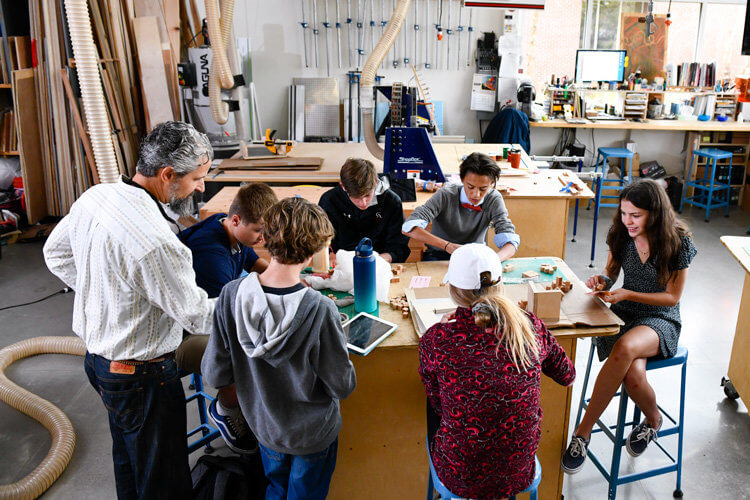
Upper School: Anderson Innovation Lab
The single place where much of Upper School computer science, engineering, and design converge is the Anderson Innovation Lab. “We can teach topics in a classroom,” says Chris Roads, who teaches Engineering and Design. “But in the Innovation Lab, we make connections and a level of understanding is added when you have to apply the knowledge. We are making makers.”
Perhaps the most well-known project to come out of the Innovation Lab is the “Tiny House” a retired CA school bus that students transformed into a tiny house, with plumbing, solar power, heat, electricity, carpentry, and interior decorating. Roads knows that some students walk into the Innovation Lab, look at the equipment, and think, “This is not for me.” He also has seen the same students transformed “with enthusiasm and energy as they take their ideas and turn them into something tangible.”
Ari Fierer took his interest in woodworking and spent his REDI Lab time using the tools in the Anderson Innovation Lab to build a line of furniture. He started his own business, Fierer Designs, and now has several commissions for additional pieces. “I liked this project because I was able to say, ‘I made this.’” Fierer says. “I created something that other people can experience. As you’re working, you have to deal with unexpected curves and twists, but at the end, you have a product that you are proud of.”
In the Innovation Lab, Upper School students have the opportunity to try Digital Design and Fabrication as well as 3D Digital Design and Fabrication. The course in Flight has students building quad copter drones. “Technology is the now the water in which we all swim, more so than ever before,” Roads says. “Without it you are limited and it’s well understood at CA that some of the deepest learning comes through doing and creating.” Although students are only required to take two courses in Computer Science/Engineering & Design to graduate, many students take additional courses.
From day one, in Pre-Kindergarten, CA’s commitment to computer science, engineering, and design does not exist in isolation. It is always developmentally appropriate for students and kept in the context of a bigger picture. “Approaching life as a maker instead of just a consumer encourages engagement in the community, connections with others, and empathy,” Roads says. “We are learning to identify the needs of others, communicate and collaborate with them, en route to designing and building creative solutions to making people’s lives better.”
